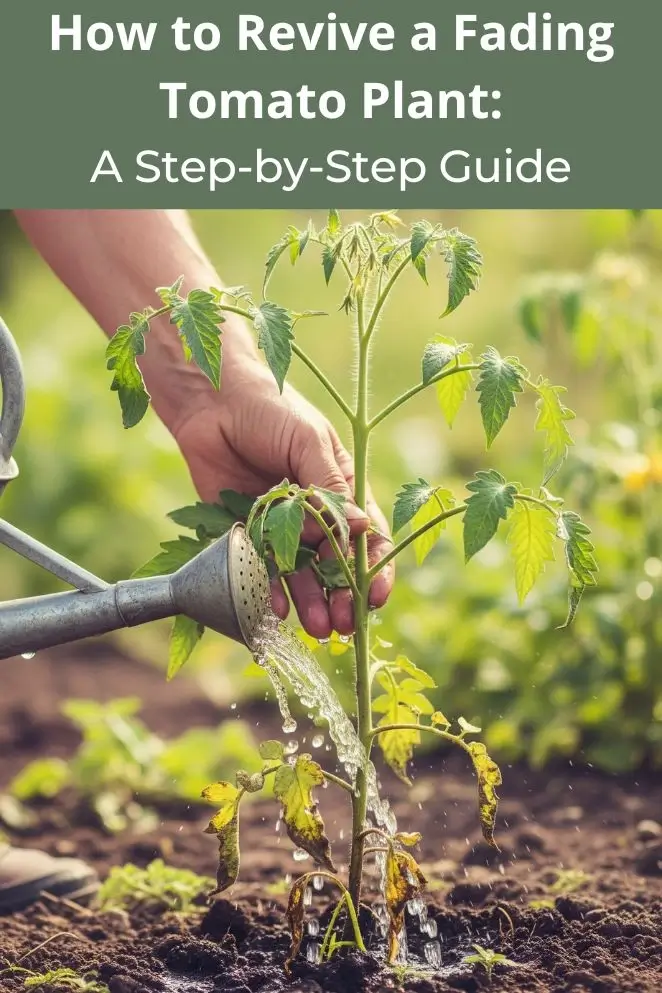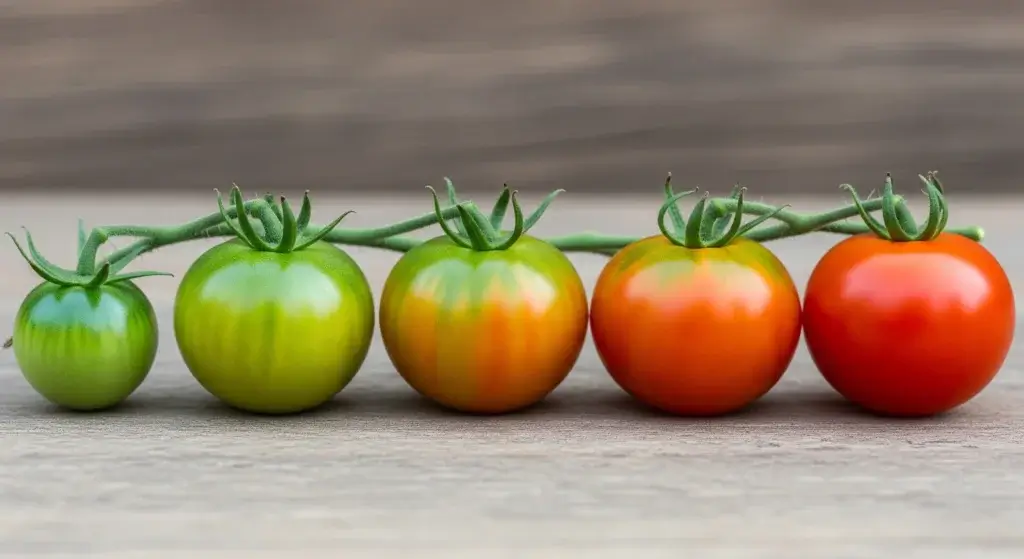
Nothing hurts more for a gardener than watching your tomato plant slowly give up on life.
Yellow leaves, droopy stems, no growth—it’s brutal. But here’s the thing: most tomato plants aren’t doomed, they’re just crying out for help.
In this guide, I’ll show you why tomatoes flop and exactly how to bring them back.
Think of it like tomato CPR—I’ve been there, watching plants crash, and I’ve also brought plenty back from the brink.
With the right moves, you can turn a sad, fading tomato into a strong, fruit-loaded champ.
Understanding Why Tomato Plants Fade
Tomato plants don’t usually just keel over overnight—it’s more like a slow drama unfolding.
The good news? That gives you plenty of chances to step in and play hero. The trick is spotting the early warning signs instead of waiting until your plant looks like it’s auditioning for a plant horror movie.
Tomatoes are tough little fighters when you cover their basics, but they’re also divas.
Too much stress, sloppy care, or sneaky diseases, and they’ll let you know real quick. I’ve lost plants by ignoring those “yellow leaf whispers” only to regret it later.
Once you learn to read these signals, though, not only can you rescue your current plant, but you’ll also be way ahead of the game for future garden wins.
Step 1: Give Your Plant a Full Check-Up
Think of this like being a plant detective—you’ve gotta scan your tomato like it’s a crime scene. Here’s what to look for:
Leaf symptoms:
- Yellow, brown, or spotty leaves (like weird freckles)
- Curling or droopy foliage
- Crispy edges (basically leaf potato chips, but not in a good way)
- Strange colors or funky patterns
Stem and root issues:
- Mushy or discolored stems (bad news, trust me)
- Cracks or sores on the stem
- Tall but flimsy “I skipped leg day” growth
- Exposed or busted roots (especially in pots)
Environmental factors:
- Soil too dry or swampy?
- How well does the water drain?
- Is the plant actually catching enough sunlight?
- Is it jammed up against a wall, fence, or another plant stealing space?
When to check
Do your inspection in the early morning. That’s when the plant is fresh and not fake-wilting from the afternoon heat.
You’ll get the real tea on what’s happening.
Step 2: Fix the water drama
Here’s the secret: about 70% of tomato fails come down to water issues.
Too little, they’re thirsty divas. Too much, they drown. Either way, they’ll make you pay.
Underwatering
- Soil pulling away from the pot edges like it’s shrinking
- Dirt bone-dry a couple inches down
- Leaves flopping even when it’s cool outside
- Stunted growth, barely making tomatoes
Overwatering
- Soil is always swampy
- Yellow leaves starting from the bottom
- Weird fuzzy fungi growing on the soil
- Roots that look dark and mushy (aka tomato horror story)
How to save them:
For thirsty plants:
- Water deeply but slowly (no plant waterboarding)
- Keep water at the soil, not the leaves
- Make sure the water soaks down 12–18 inches—deep roots = strong plants
- Stick to watering when the soil actually needs it, not just because it’s “Tuesday”
For drowned plants:
- Chill with the watering can—stop for a bit
- Improve drainage (add compost, fix the pot, whatever it takes)
- Dump any standing water under the pot
- If roots are rotting, repot with fresh, airy soil
Watering like a pro
Tomatoes are sun junkies—they need 6–8 hours of direct light daily.
The hotter it gets, the thirstier they get.
On average, one mature plant needs about 1–2 inches of water per week.
Go for fewer, deep waterings instead of tiny sips every day.
Pro tip: Stick your finger 2–3 inches into the soil. If it’s dry, water. If it’s still damp, back off.
The plant doesn’t need a shower just because you feel like giving it one.
Step 3: Get the Light Game Right
Tomatoes are basically sun addicts.
If they don’t get enough rays, they turn weak, floppy, and sickly, like someone who spends all summer in the basement playing video games.
How much sun they need
At the bare minimum, 5 hours a day keeps them alive.
But if you want strong plants pumping out fruit like champs, aim for 6–8 hours of direct sunlight. Without it, you’ll see:
- Tall, spindly “I’m reaching for the sun but not getting it” growth
- Barely any flowers or fruit
- Easier target for diseases
- Overall wimpy plant vibes
How to fix the light situation
For garden tomatoes:
- Chop back trees, bushes, or anything throwing shade where it doesn’t belong
- Next season, pick a sunnier spot if this one’s a dud
- Use reflective mulch (basically shiny ground covers) to bounce light onto the lower leaves
For potted tomatoes
- Drag those pots to the sunniest corner you’ve got
- Use plant caddies with wheels so moving them isn’t a workout
- Spin the pots weekly so all sides get sun-kissed evenly
- If you’re in a gloomy spot, yes—you can even cheat with grow lights
Step 4: Feed Your Tomatoes Like Athletes
Here’s the thing—when your tomato looks weird, it’s often not “disease,” it’s “I’m starving, please feed me.”
The leaves tell you exactly what they’re missing, like plant Snapchat streaks begging for attention.
What hunger looks like
- Nitrogen deficiency: Old leaves turning yellow, plant looking short and sad, barely any fruit
- Phosphorus deficiency: Purplish or reddish leaves, weak roots, late to flower (the procrastinator plant)
- Potassium deficiency: Crispy brown edges, low-quality fruit, weak immune system
- Calcium deficiency: The dreaded blossom end rot (black bottoms on fruit), twisty leaves, stunted new growth
How to feed them right
Tomatoes love organic foods—stuff like blood meal, bone meal, kelp, compost, or even bat poop (yep, gardeners actually use that).
Fertilizer game plan:
- Week 1: Start with a balanced fertilizer (10-10-10 type) but only at half-strength
- Week 2–3: Keep feeding weekly, slowly boosting to full-strength
- After that: Switch to tomato-specific food that’s higher in potassium (that’s the “fruit booster”)
- Extra help: If blossom end rot shows up, add calcium with eggshells, bone meal, or even calcium sprays
Pro feeding tips:
- Always water before and after fertilizing so the roots don’t get fried
- Do it in the morning or evening, not in blazing sun (unless you like crispy leaves)
- Never fertilize a thirsty, stressed plant—it’s like making someone run sprints without giving them water first
Step 5: Fight Off Diseases and Pests
Tomatoes are drama magnets—they catch all sorts of diseases, especially if it’s hot and humid.
The trick? Catching problems early before they turn your plant into a mushy mess.
The most common tomato diseases
Fungal
- Early blight: dark spots with “target rings” on leaves
- Late blight: nasty brown-black patches that spread fast
- Fusarium wilt: bottom leaves turn yellow, then the plant crashes
- Verticillium wilt: weird yellowing between leaf veins
Bacterial
- Bacterial spot: tiny dark speckles on leaves and fruit
- Bacterial canker: plant wilts even though the soil’s wet
Viral
- Tomato spotted wilt virus: bronzy leaves with funky ring spots
- Tobacco mosaic virus: mottled yellow-green patterns like bad tie-dye
How to deal with it
Quick actions
- Yank off infected leaves and toss them in the trash (never the compost, unless you want “zombie plant disease” spreading)
- Space plants out so air can move around
- Always water at the base, not over the leaves
- Use fungicides or bactericides if things get ugly
Prevention hacks:
- Rotate crops yearly—don’t put tomatoes in the same soil season after season
- Go for disease-resistant varieties when you can
- Avoid overhead watering (sprinklers are plant gossip central for spreading disease)
- Keep tools clean, like a plant surgeon
- During muggy weather, hit them with preventive sprays
The pests you’ll meet
Tomato hornworms, aphids, whiteflies, cutworms…basically the all-you-can-eat buffet crowd.
Ways to handle them:
- Big guys like hornworms? Hand-pick ‘em. (Yes, they’re gross, but also kinda cool-looking.)
- Recruit ladybugs, lacewings, and tiny parasitic wasps—they’re nature’s pest police
- Spray with neem oil, insecticidal soap, or BT (a natural bacteria that kills caterpillars)
- Block pests with row covers, sticky traps, or copper strips (slugs hate copper)
Step 6: Give Your Tomato Recovery Support
Sometimes a struggling tomato just needs a little backup—like crutches for plants.
Structural support options
- Pop in or adjust a tomato cage
- Stake it up with soft ties (don’t strangle it)
- Build a trellis if it’s an indeterminate variety that wants to climb forever
- Try tomato spirals—they spread the weight better
Pruning
Pruning isn’t punishment—it’s about helping the plant focus on survival and fruiting.
- Cut off lower leaves touching the soil (that’s where diseases sneak in)
- Snap off suckers (those little shoots that grow between the main stem and branches)
- Trim away dead or diseased growth—it’s just wasted energy
- If your plant looks too stressed, sacrifice some flower clusters so it can recover instead of overworking itself
Make the environment comfy again:
- Mulch it up: 2–3 inches of straw, shredded leaves, or compost keeps soil moist, cool, and weed-free, while feeding the plant slowly
- Block strong winds with screens, taller plants, or temporary barriers so your tomato isn’t fighting a windstorm while trying to heal
Step 7: Keep Watch and Adjust
Rescuing a tomato isn’t one-and-done—it’s more like rehab.
Signs it’s working (in 1–2 weeks)
- Fresh new growth
- Leaves looking greener and less droopy
- Wilting reduced
- More flowers popping up
Signs of trouble
- Plant keeps declining even with treatment
- Disease keeps spreading
- New pests move in
- Wilting doesn’t quit
When to switch things up
- If progress stalls: run a soil test to check pH and nutrients
- If new issues appear: re-check your watering, spacing, and care routine
- If recovery’s dragging: remember, you need to tackle all stressors, not just one
Conclusion
Bringing a fading tomato back is totally doable — it just takes patience, sharp observation, and a step-by-step plan.
Start with the obvious stuff (water, light, pests), then fix nutrients, support, and soil while you watch for signs of recovery.
Think of these rescue moves as prevention practice too — they stop future drama before it starts.
Stick with it, be patient, and you can turn a sad plant into a fruiting machine — big flex for your garden game.



